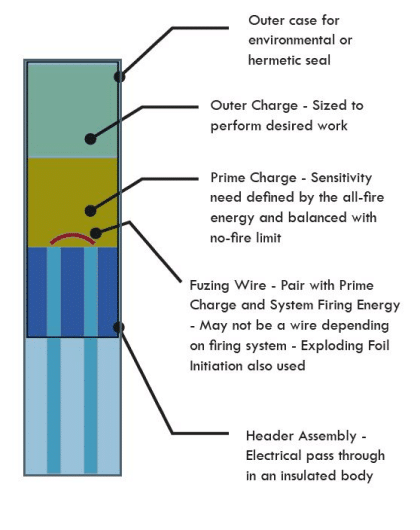Qualification Determination
There are 4 main reasons to perform a qualification:

Part Geometry
Size
Weight
Connector Mating (pin out)

Performance Gaps
Function Time
Function Pressure
Thermal Capabilities
Mechanical Capabilities
Service/Shelf-Life Limitations
ESD Capabilities
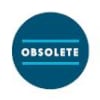
Obsolescence
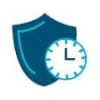
Reliability
Part Geometry
Part geometry is a definite reason to perform qualification. Some examples include a part that needs to be made smaller or lighter, or if the connectors change.
Performance Gaps
Performance gaps are another reason to perform a qualification. One example may be the function time has changed, and the current design doesn’t apply. Output performance can be measured by dent which is an effect of detonation velocity for different materials. Sometimes there are thermal capabilities and a change might need to be made to the explosive materials to meet requirements. Mechanical capabilities of the design could change which affects qualification. A design may have too short of a life. For example, a 50-year service shelf-life combination is needed for nuclear deterrent items. This limitation drives design changes which, in turn, drives qualifications. Lastly, from safe handling electrostatic to discharge capabilities, all ordnances in assembly need to be safe for the operator. Electronic Safety Device (ESD) capability design is important and is verified through the qualification process.
Obsolescence
Obsolescence is another big driver for qualification. If a part of the design is changed and it cannot be manufactured or procured anymore, then it becomes obsolete. A redesign is necessary which also means a qualification must be performed.
Reliability
In the instance the current design is not reliable enough for the new or existing application then qualification must be performed. Therefore, reliability also drives qualifications
Qualification Path
Department of Defense (DoD)
We work with several sponsors of The Department of Defense to qualify design. The U.S. Navy, Air Force, Army, and Space Force coordinate together to champion the sponsorship of a qualification. In the end, the qualification is presented to the Safety Board of a specific branch, and they approve the qualification range.

Range Safety
Safety is another qualification path and customer that oversees the design to protect the ranges.
Commercial
The commercial route consists of Commercial Non-aerospace and Commercial Aerospace, and they also require qualification.
Foreign Military Sales
Foreign Military sales are typically less hands on, but the process is still the same and they do require designs to be qualified.
Overview of Component for Qualification
Design and Energetics Require Qualification Considerations
This is a placebo design for qualification. Figure 1 is a simple Hot Wire Bridge Squib Initiator. It could be a detonating output. The green is represented as an output charge that could be pressure generating or detonator generating. The energetic component itself needs to be qualified. The orange represents the Hot Bridge Wire Ignition Prime Charge which also needs to be qualified. The interface between those has its own statistical test that will determine reliability for all-fire and no-fire. Additionally, the whole package must be sealed from moisture environments. Most designs are required to be hermetically sealed. Typically, a header assembly glass to metal seal is used. Then, a steel vessel is wrapped, welded, crimped, or glued together to keep the salt and moisture environments outside the explosive train. Qualifications help vet this process.
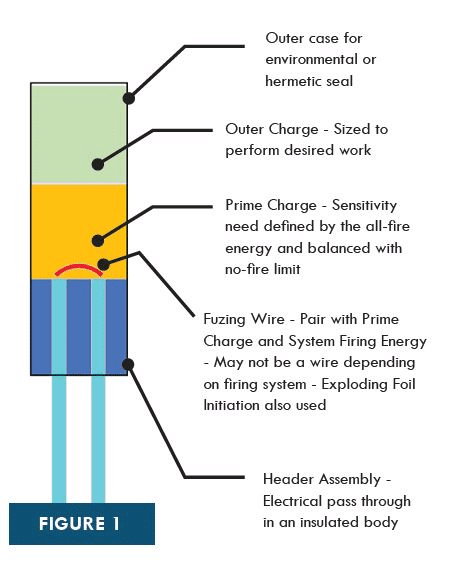
DOD Qualification
Device Design Must Include Qualified Energetic Train
MIL-DTL-23659 Rev F is the biggest standard for many Electro-Exploding Foil Initiators and Hot Bridge Wire designs. It is a design guide with performance requirements.
Energetic materials, similar to the orange and green components in Figure 1, need to be on the SW010-AG-ORD-010 Technical Manual List of Qualified Explosives to be qualified for Department of Defense use. This list means the explosive needs to be tested per a test matrix for NAVSEAINST 8020.5 which is governed by the NATO document A0P-7. A0P-7 is a manual for qualification of explosives for military use.
Figure 2 is a puck of one of our explosive materials. In our industry, it is common for primary explosives to have a 10-gram limit to protect the operators dealing with the energetic.
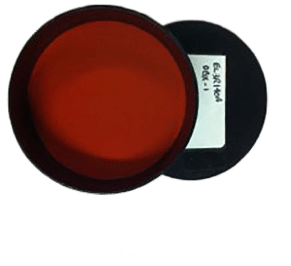
Test Matrix MIL-DTL-23659, DOD
Below is a full qualification matrix from MIL-DTL-23659 Rev F. As mentioned before, this standard is for Department of Defense applications. The matrix has a lot of columns and breaks down a lot of tests. Overall, the matrix has 416 units which takes a serious amount of time to create. All the serial numbers are coordinated and run through different environments. Some are separately run, and others are combined run. Once all of that is completed there are still additional statistical tests that need to be added to the matrix to have a qualified design.
Some tests, like the cookoff test, are simple and require a 22-piece sample to run. Others, like high temperature exposure, require more units when running the test. In this case, if the guidance of 23659 is followed, then it will quickly become known that 416 plus units are necessary.
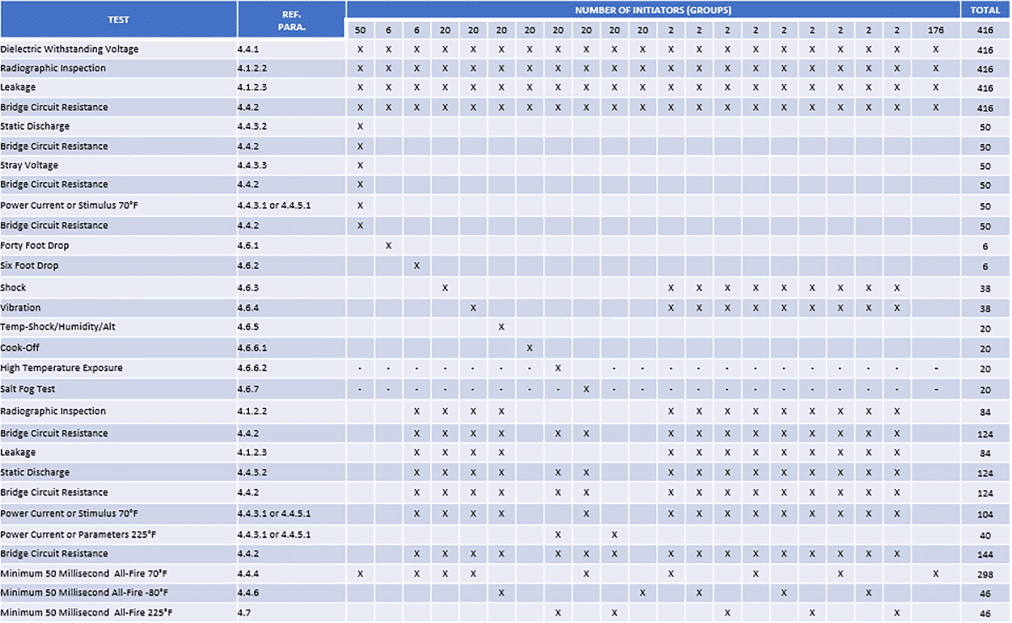
To the right is a typical test matrix for the AIAA S-113 used for space applications. There is a minimum of 120 units on this test qualification matrix for first fire initiation for Exploding Foil Initiators, Hot Bridge Wires, and Exploding Bridge Wires. The matrix has 120 units, but it also has A, B, and C inputs which are to be determined. The RF sensitivity typically runs 220 units plus the ten. 230 units is typical to complete the RF impendence and RF sensitivity. The no-fire and all-fire statistical tests are 30 units a piece for a Hot Bridge
Wire type design.
This matrix is a large sample and provides a thorough stress of the units. The cyber survivability test is a 13.3-meter drop which is performed to ensure the energetic won’t go off and possibly injure somebody. The test is another instance of ensuring the component is safe to handle and is representative of an installation on a launch vehicle that is 40 feet off the ground.
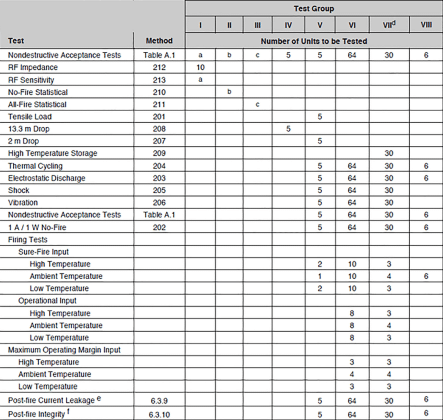
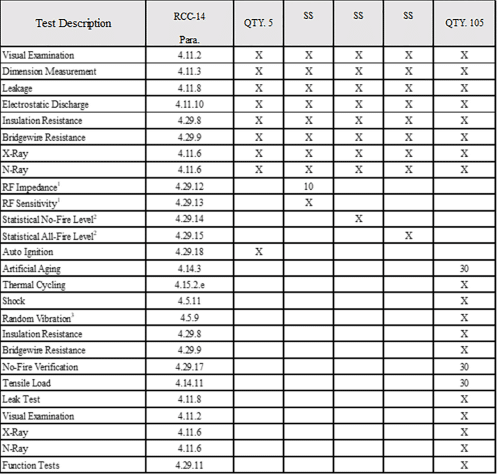
Test Matrix RCC-319, Test Range
To the left is a test matrix from one of three RCC-319 test range documents. This significant sample, like the others, is a minimum. The minimum test quantity for RCC-319 is 110 units. Like the AIAA document, this matrix also has RF sensitivity, RF impendence, statistical All-Fire, and statistical No-Fire. Those units are to be determined and presented to the range and then tested. It is likely 230 units plus 60 units over the 110 units to be fully qualified to RCC-319.
Test Matrix, Primary Explosive, AOP-7 / 8020.5
Below is an example of an 8020.5 test matrix which is governed by the AOP-7, a NATO document manual for requirements of qualifications of explosives. These tables are presented to a Department of Defense (DoD) sponsor. The DoD sponsor approves the test matrix and quantities before proceeding into test.
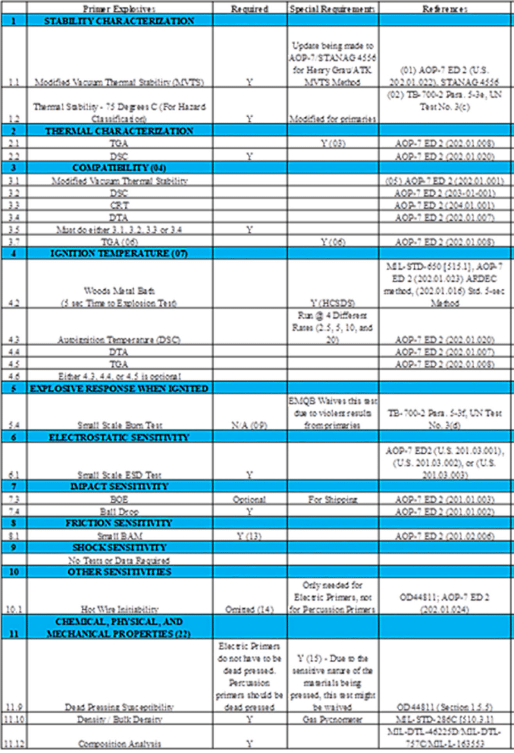
During the testing process, the explosives are stored in a humidity-controlled environment for a minimum of 12 months. It is a long process to qualify for, the process usually takes 2 years for a new explosive. It is an arduous process to go through all the following steps:
- Chemical Test
- Mechanical Properties Test
- Stability Test
- Standard Physical Test for Safety Impact Friction ESD
- Electrical Test
- Performance Test
- Real Time Aging Test
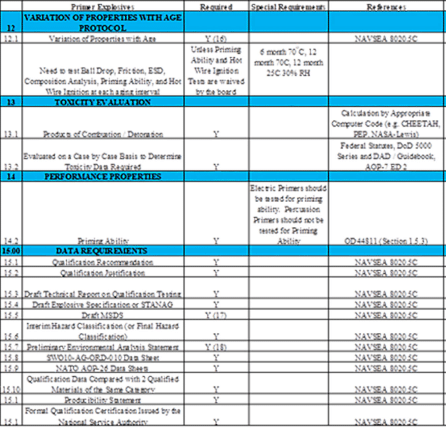
Rocket & Missile Motor Ignition Systems
Limited Explosive List Allowed
Rocket Motor Ignition systems have their own requirements which limit the type of explosive but also pair up with some of the previous requirements, such as 23659. Table 1. Approved Pyrotechnics and Table 2. Approved Explosives to the right are pulled from MIL-STD-1901A. Initiators must be pulled out of alignment. The only exception is if they are high voltage designs that do not fire under 500 volts.
Fusing Considerations
Limited Explosive List Allowed
Fusing has its own package with qualification requirements. The explosive needs to be qualified and the manufacturer of the explosive needs to be qualified to AOP-7. The initiators must be out of alignment because it is with a warhead. Referring to Table 1 – Approved Explosives, Tetryl is out there in some fuses, but it is no longer approved for new designs. The explosives with plus symbols have weight limits of 3 grams max.
Additional Test
Understanding of Full Requirements Required
Additional units beyond the 416 units are required to complete the MIL-DTL-23659 test matrix. Statistical testing is needed to verify the All-Fire and No-Fire requirements
in either a Class A Standard Hot Bridge Wire design or a Class B High Voltage design.
There are three methods of statistical testing:
- Neyer D-Optimal
- Langlie
- Bruceton
- No longer acceptable for MIL-DTL -23659 Rev F use and beyond or the All-Fire, No- Fire determination
- Required for NAVSEA Qualification of Explosives 8020.5
- Accepted for AIAA S-113 use
Typically, the 23659 All-Fire tests for Hot Bridge Wire designs are run here. We run the All-Fire at worst case -80°F. The No-Fires are run at worst case +225°F. These tests determine the design robustness. Proof reliability is a primary driver for qualifications and statistical testing supports key characteristics to determine that reliability. Test Method Standard Deviation Variation Comparison

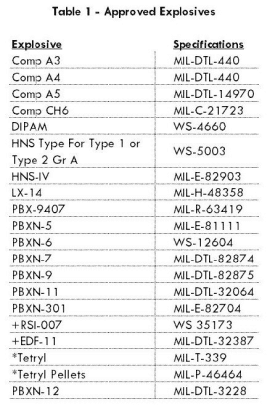
Test Method Standard Deviation Variation Comparison
Below is a useful graph that helps determine which method should be used. The variance in standard deviation is on the Y-axis and the X-axis represents sample sizes.
Pictorially, it is easy to see the Bruceton method has a lotmore variance and requires many more samples to drive to standard deviation to determine statistical reliability. The Langlie method is like the Neyer D-Optimal method, but the cross-over sample size is so small that it proves insignificant. The typical sample size required for many Hot Bridge Wire designs is 30 units. If the Neyer D-Optimal software had been purchased and is readily accessible then it should be used, for this is the ideal method. Otherwise, the Langlie method can be accessed on the internet and is usually free. If a lower budget is desired, then this is a good proven method.
To learn more about the three different statistical methods used in design, refer to the MIL-STD-83578 and AIAA S-113 handbooks.
These handbooks include this table, a detailed explanation of the 3 different methods, and the strengths/limitations of each.
- The MIL-STD-83578 is a free document
- The AIAA S-113 must be purchased
Additionally, Langlie includes a handbook with their free download and Bruceton includes a thorough handbook with the purchase of their software. Bruceton is extremely dependent on step size in the test. There must be a minimum
number of crossovers and the step size must be determined. All four steps must be taken when getting All-Fires and No- Fires, and the line will need to be crossed over a few times. It is common to get through 50 parts, not have a valid test, and need to start all over again.
Overall, use the best method you have available for sample size purposes, less development span, and less over design use.
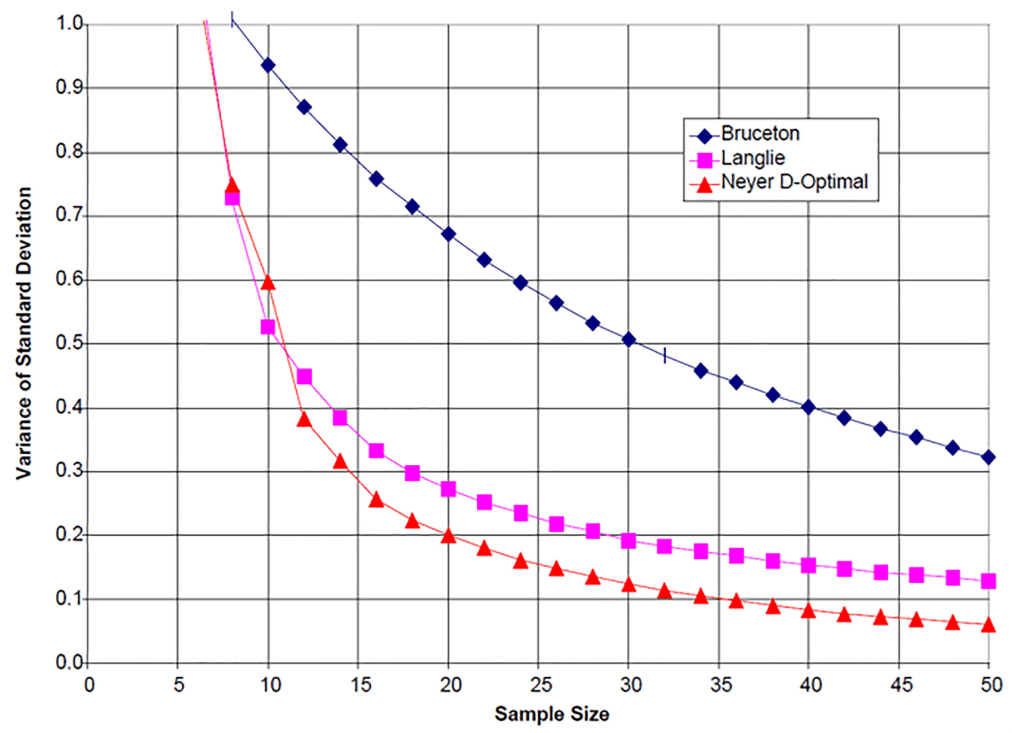
Timeline Considerations
An All-New Design Is Typically Schedule Prohibited After experimentation is complete and the new energetic is created, there is a 2-year cycle to qualify. Another 1 to 1.5 years is added on afterwards to do a full qualification. This
is dependent on how complex the design is and how easy the components are to acquire. With current supply chains this process is more difficult.
Delta qualifications are commonly used to reduce this schedule. There are many benefits associated with these qualifications. First, the matrix is tailored and requires less units, but, as a manufacturer and designer, it is still
necessary to work with a sponsor. It is best to work with them during the early stages. Make sure to put the matrix in the proposal and give the sponsor or customer a good idea early on of what needs to be done to bridge the
baseline qualification to a new qualification.
It is key to use previously approved explosives as much as possible. Doing so eliminates the prohibitive 2-year qualification process. Additionally, as far as we are aware, Delta qualification is not done on new explosives. It has
most likely been done before to subtle changes, such as a binder in a propellant, but those are few and far between. A new explosive is harder to qualify.
A qualification by similarity analysis is needed to present a Delta qualification. It is a report with data and analysis showing past results and predicted results. This analysis helps to eliminate safe salt fog, or 40-foot drop tests if the design hasn’t been changed to impact the hermetically sealed stainless steel. If the amount of explosive in a device changes, then it will need a new part number and may need to go through some environments to demonstrate that it didn’t change anything, but there are several tests you won’t have to do. This qualification analysis may also be supported by additional tests to a similar design.
Summary
Test Matrix and Specifications Guide the Qualification Program In conclusion, this design showed earlier is covered with the test matrixes presented. The explosives are qualified. The system is qualified. The interface between the electronic and
chemistry is vetted through statistical analysis.
